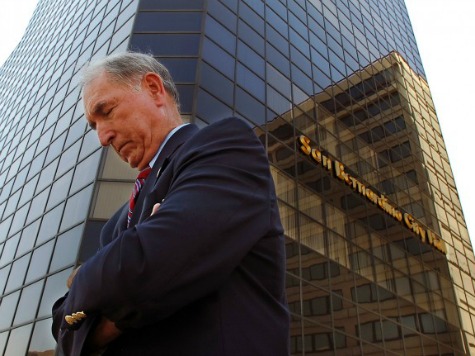
How does a city of 200,000 people go bankrupt? In the case of San Bernardino, CA, the answer is unsustainable pension obligations pushed by union-backed politicians.
San Bernardino declared bankruptcy in July, citing “an immediate cash flow issue,” but the collapse has been a long time coming and was not the result of a single decision or mistake. Elected officials consistently chose to offer public-sector unions overly-generous benefits, both in terms of salaries and pensions, even as the tax base of the city was shrinking.
Between 1997 and 2010, the salary of a city firefighter doubled to just shy of $150,000. Firefighters and police routinely took advantage of rules which allowed them to be paid for a percentage of accrued sick leave and vacation hours:
In 2009, patrol lieutenant Richard Taack retiredat the age of 59, after 37 years of service. He took home $389,727 thatyear, including $194,820 in unused sick time and $33,721 for unusedvacation time, according to city payroll records. Shortly after Taackretired – on an annual lifetime pension of $128,000 – he was hiredpart-time by Penman’s city attorney’s office, at $32 an hour.
Asked about these payouts, the head of San Bernardino’s firefighter union told Reuters, “If you call in sick, you’re a bad employee. So myguys don’t call in sick. Then you get all this time you are owed – andyou get vilified.”
The unions are taking advantage of the rules, but the rules themselves are voted on by members of the city council. For much of San Bernardino’s history, the council has been dominated by union-backed candidates who supported the increased wages and pensions.
In 2007, as the financial downturn was beginning to hit, the city council was set to vote on a generous proposal sought by unions that would allow city workers to retire at age 55 with 2.5% of their final salary for every year worked. At the last moment, the city attorney brought out a special witness:
According to four people present at the meeting,Penman, the city attorney, brought a pregnant co-worker to the session.By their account, Penman’s co-worker made an emotional case for an evenmore generous pension deal. Otherwise, she said, she would be forced toleave San Bernardino and seek work in a city with better benefits. Shehad her family to consider, she said.
After the presentation, the city council voted to approve the proposal with one change: workers would get 2.7% per year upon retirement.
The city council was explicitly warned the path they were on was unsustainable more than two years ago. In August 2010, San Bernardino’s city manager Charles McNeely gave a presentation in which he warned of a looming $40 million deficit if something didn’t change. He claims he told the council the finances were “a train wreck.”
McNeely quit in March 2011. Nothing changed except that earlier this year union-backed candidates regained their majority on the city council.

COMMENTS
Please let us know if you're having issues with commenting.